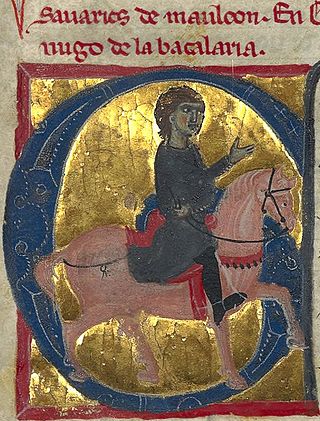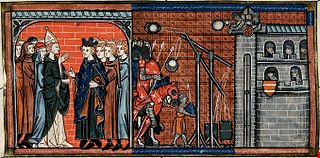
The Lord Warden of the Cinque Ports is a ceremonial official in the United Kingdom. The post dates from at least the 12th century, when the title was Keeper of the Coast, but may be older. The Lord Warden was originally in charge of the Cinque Ports, a group of five port towns on the southeast coast of England that was formed to collectively supply ships for The Crown in the absence at the time of a formal navy. Today the role is a sinecure and an honorary title, and fourteen towns belong to the Cinque Ports confederation. The title is one of the higher honours bestowed by the Sovereign; it has often been held by members of the Royal Family or prime ministers, especially those who have been influential in defending Britain at times of war.

There were six major officers of the Kingdom of Jerusalem: the constable, the marshal, the seneschal, the chamberlain, the butler and the chancellor. At certain times there were also bailiffs, viscounts and castellans.

The Angevin Empire was the collection of territories held by the House of Plantagenet during the 12th and 13th centuries, when they ruled over an area covering roughly all of present-day England, half of France, and parts of Ireland and Wales, and had further influence over much of the remaining British Isles. It may be described as an early example of a composite monarchy. The empire was established by Henry II of England, who succeeded his father Geoffrey as Duke of Normandy and Count of Anjou. Henry married Eleanor of Aquitaine in 1152, acquiring the Duchy of Aquitaine, and inherited his mother Empress Matilda's claim to the English throne, succeeding his rival Stephen in 1154. Although their title of highest rank came from the Kingdom of England, the Plantagenets held court primarily on the continent at Angers in Anjou, and at Chinon in Touraine.

Savari de Mauléon was a French soldier, the son of Raoul de Mauléon, Viscount of Thouars and Lord of Mauléon.

The County of Poitou was a historical region of France, consisting of the three sub-regions of Vendée, Deux-Sèvres and Vienne. Its name is derived from the ancient Gaul tribe of Pictones. The county was bounded on the north by the Duchy of Brittany, the counties of Anjou and Touraine, on the east by the County of La Marche and on the south by the County of Angoulême. The seat of the county was at Poitiers.
William des Roches was a French knight and crusader who acted as Seneschal of Anjou, of Maine and of Touraine. After serving the Angevin kings of England, in 1202 he changed his loyalty to King Philip II of France and became a leading member of his government.
The Seneschal of Anjou was an officer of an aristocratic household assigned to manage the domestic affairs of the lords of Anjou. During the course of the twelfth century, the seneschalship also became an office of military command.
Robert of Thurnham was an English soldier and administrator. The namesake of his landowner father, he was the younger brother of Stephen of Thurnham. Robert made his reputation in connection with the conquest of Cyprus in 1191 during the Third Crusade. On order of King Richard I, he led half the fleet in that battle. Subsequently, he was responsible for controlling the island when the Crusaders moved on, first jointly with Richard de Camville and then independently, when he defeated a group of Cypriot rebels. After he left Cyprus, Robert became more closely identified with Richard I. As the king's familiaris, he carried Richard's equipment from the Holy Land to England. When Richard I was captured in 1192 in Vienna, among the terms of his release was the presentation of men to stand as "pledges" that the ransom would be paid. Robert was among these hostages, though evidently not for long, as he was back by the king's side in 1194 at Poitiers. Appointed Seneschal of Anjou, he served in France with Richard I, primarily in Anjou and Normandy, throughout the rest of Richard's reign. At around the same time, he was also appointed High Sheriff of Surrey, but he did not return to England until after Richard's death. In 1196, he led troops at Richard's behest into Brittany on an unsuccessful attempt to capture the child Duke of Brittany Arthur, whose mother Constance was resistant to Richard's control. In 1197, King Richard arranged for Robert to marry Isabella Fossard, daughter and heiress of the powerful Yorkshire baron William Fossard. The Fossard inheritance included the castle, honor, and lordship of Mulgrave with 34.5 attached knight's fees.

Agnes of Burgundy was Duchess of Aquitaine by marriage to Duke William V and Countess of Anjou by marriage to Count Geoffrey II. She served as regent of the Duchy of Aquitaine during the minority of her son from 1039 until 1044. She was a daughter of Otto-William, Count of Burgundy and Ermentrude de Roucy and a member of the House of Ivrea.

The siege of La Rochelle of 1224 was the decisive engagement in the campaign between the Capetians and the Plantagenets for control of Poitou. French royal forces commanded by Capetian king Louis VIII laid siege to the strategic port of La Rochelle and its garrison of Poitevin and English soldiers commanded by Savari de Mauléon. The port had long been a staging ground for Plantagenet efforts to regain their continental lands lost to the French crown since 1203. The siege lasted from July to August 1224, and resulted in La Rochelle's citizens surrendering the city to Louis after the failure of English relief to emerge. The siege of La Rochelle was the crowning event of the Capetian conquest of Poitou from the Plantagenets. With Poitou in Capetian hands, only Gascony remained under Plantagenet rule on the continent.
The Seneschal of Gascony was an officer carrying out and managing the domestic affairs of the lord of the Duchy of Gascony. During the course of the twelfth century, the seneschalship also became an office of military command. After 1360, the officer was the Seneschal of Aquitaine. There was an office above the seneschalcy, the Lieutenancy of the Duchy of Aquitaine, but it was filled only intermittently.
The Seneschal of Normandy was an officer carrying out and managing the domestic affairs of the lord of the Duchy of Normandy. During the course of the twelfth century, the seneschalship, also became an office of military command.
Geoffrey de Neville was an English nobleman who served as King's Chamberlain and Seneschal of Gascony and Périgord.

Renaud de Pons was a nobleman from the Saintonge. He served as Seneschal of Gascony between 1214 and 1217 and briefly as Seneschal of Poitou in 1216. He went on the Fifth Crusade in 1217–21. He and his nephew, Renaud II de Pons, are distinguished in contemporary documents by the epithets senior and iunior. He is also known by the epithet Palmarius because he was a crusader.
The Seneschal of the Landes was an officer carrying out and managing the domestic affairs of the lord of the district of Landes, Bayonne and Labourd in the former Duchy of Gascony. Created in 1255, from a division of the position of Seneschal of Gascony, the seneschalship, also became an office of military command.
The Seneschal of the Saintonge was an officer carrying out and managing the domestic affairs of the lord of the district of the Saintonge, a province of France in the late Middle Ages. During the course of the twelfth century, the seneschalship, also became an office of military command.
The Seneschal of the Agenais was an officer carrying out and managing the domestic affairs of the lord of the former county and district of Agenais. During the course of the twelfth century, the seneschalship, also became an office of military command.

Hugh de Vivonne was a French knight from Vivonne in the County of Poitou. He was loyal to the Plantagenet family and supported their right to vast lands in France. From 1215 onward he made his home in England, where he was constable of Bristol Castle and later High Sheriff of Somerset and Dorset (1241–49). He married an English lady and became lord of Chewton and Curry Mallet. He received further English estates in compensation for the loss of his lands in France. Yet, as a foreign soldier in the king's pay, he has been described as merely a "Poitevin mercenary captain".
The Seneschal of Ponthieu was an officer carrying out and managing the domestic affairs of the lord of the County of Ponthieu. During the course of the twelfth century, the seneschalship, also became an office of military command.

Geoffrey of Lusignan was the Lord of Vouvant and Soubise, and Count of Jaffa and Ascalon. He was also Lord of Mervent and Moncontour by his wife's rights.









